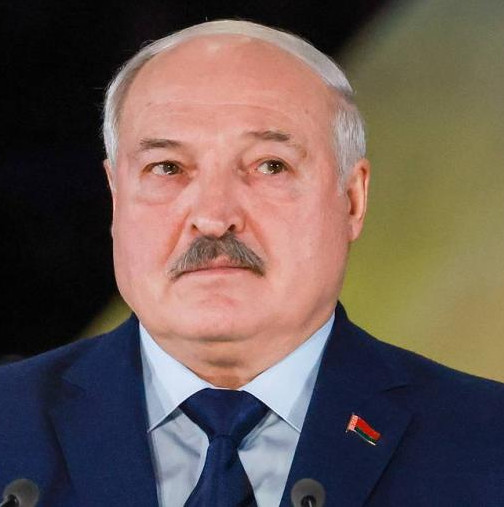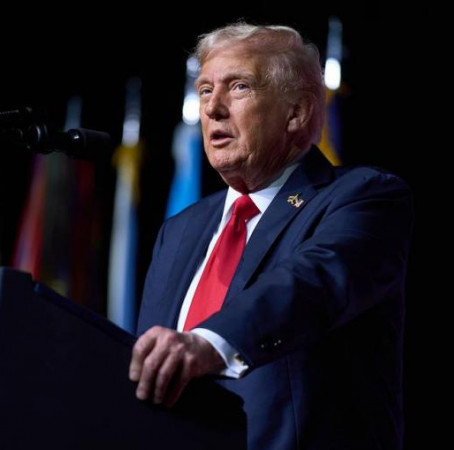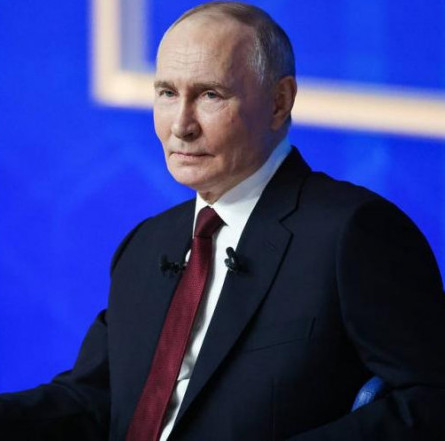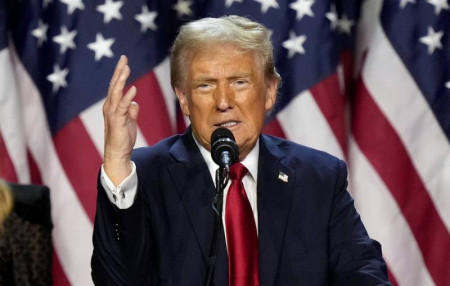Washington and Moscow have initiated discussions on Trump’s meeting with Russian President Vladimir Putin without waiting for his inauguration. Meanwhile, US officials are working to finalize an agreement between Israel and the radical Palestinian movement Hamas in the coming days; and Iranian President Masoud Pezeshkian is scheduled to visit Moscow on January 17 to sign the Comprehensive Strategic Partnership Agreement. These stories topped Monday’s newspaper headlines across Russia, according to TASS news agency.
Kommersant: Trump announces possible meeting with Putin after inauguration
Without waiting for the inauguration of US President Donald Trump, scheduled for January 20, Washington and Moscow have reportedly started preliminary discussions about a potential meeting between Trump and Russian President Vladimir Putin, Kommersant reports. Based on statements from Russian presidential spokesman Dmitry Peskov, Putin would be ready to meet Donald Trump without any preconditions.
Moscow remains cautious about the outlook for future interactions with the US President-elect. This caution stems not only from the ongoing confrontation in US-Russia relations but also from past dealings with Trump’s administration during 2017-2021. During that period, the US imposed numerous sanctions on Russia, withdrew from critical arms control agreements, and declared a new era of strategic competition with both Russia and China.
Dmitry Suslov, Deputy Director of the Center for Comprehensive European and International Studies at the Higher School of Economics, told Kommersant that Trump’s second term could present greater opportunities for implementing agreements with Russia. "First, because this time there are no lingering accusations of so-called Russian interference in the US elections, nor claims of collusion between the Kremlin and Trump’s team. He is now perceived as a legitimately elected president. Second, Trump’s emerging team is expected to show more internal unity, unlike his first term when some individuals actively undermined his foreign policy, including decisions related to Russia. Third, the Republicans will control Congress for at least the next two years," Suslov explained.
However, the expert warned against expecting any significant breakthroughs. He remains skeptical about the likelihood of Moscow and Washington reaching an agreement on Ukraine.
"The terms for resolving the Ukrainian conflict that Russia might find minimally acceptable would appear to the US as a catastrophic defeat. Against this backdrop, any concession to Russia - such as on the crucial issue of Ukraine’s demilitarization—would likely provoke hostility from both Republican and Democratic hawks, as well as US allies in Europe," he concluded.
Vedomosti: Can Israel and Hamas reach ceasefire before Trump assumes office?
US officials are attempting to broker an agreement between Israel and the radical Palestinian movement Hamas in the coming days, even before President-elect Donald Trump re-enters the White House on January 20, Axios wrote, citing an anonymous Israeli official. This effort is reportedly being led by the special envoy of the future Trump administration for the Middle East, Steve Witkoff, who is already engaged in negotiations during meetings in Israel and Qatar. Experts interviewed by Vedomosti estimate the probability of a ceasefire between Israel and Hamas by January 20 to be around 10-15%.
On January 12, an Israeli delegation traveled to Qatar for talks on a potential deal to secure the release of hostages. The Jerusalem Post reported, citing sources, that the decision to send the delegation to Doha was prompted by progress in the prior round of negotiations.
Sergey Balmasov, senior expert at the Middle East Institute, estimates the likelihood of a ceasefire between Israel and Hamas by January 20 at about 10-15%. He believes the current situation in the Middle East is favorable for Israel, given the weakened state of the Hamas-aligned Hezbollah movement in Lebanon and Iran’s diminished influence in Syria following the fall of President Bashar al-Assad.
Lyudmila Samarskaya, research fellow at the Center for Middle East Studies at the Institute of World Economy and International Relations, concurs with these assessments. She notes that while optimistic projections for a potential deal between Israel and Hamas have been made in the past, the talks often collapse at the last moment due to irreconcilable differences in the parties’ positions.
Meanwhile, Balmasov argues that the main objective of dispatching an Israeli delegation, headed by the Mossad director, to Doha is to create a diversion for the Americans and local opposition, allowing the IDF to regroup and intensify its offensive in Gaza. Trump’s warnings about "all hell" breaking out in the Middle East if no agreement is reached by January 20 indicate that the new White House administration may be prepared to "unleash its ally" and provide additional military resources, Balmasov observed. These resources will likely be redirected from the Ukrainian front, which could trigger unpredictable consequences for the broader Middle East, the expert added.
Kommersant: Moscow, Tehran plan to sign Comprehensive Strategic Partnership Treaty
Iranian President Masoud Pezeshkian is set to visit Moscow on January 17 for talks with his Russian counterpart Vladimir Putin and the signing of the Comprehensive Strategic Partnership Agreement. The new document will supersede the outdated 2001 agreement and elevate relations between Moscow and Tehran amid their escalating tensions with the West, Kommersant reports. An Iranian diplomatic source informed Kommersant that one of the key priorities will be collaboration with Moscow in the areas of security and defense.
An Iranian diplomatic source stated, "A significant portion of the agreement will focus on trade, economic, and energy cooperation, along with a partnership in defense and security matters."
"The development of this agreement began back in 2014 and has continued through multiple Iranian administrations. The document prepared for signing is essentially an enhanced version of the long-term cooperation agreement finalized by the two countries in late 2001. From 2003, when this agreement came into force, it remained valid for ten years until 2013, after which it was automatically extended for five-year periods. Currently, this document continues to serve as the foundation of Iran-Russia partnership. However, as Iran and Russia have broadened their cooperation across various domains over the past two or three decades, we recognized the need to update the previous document to align with the new realities and the expanded scope of our relations," the Iranian source told Kommersant.
Russia and Iran are making this bold move towards closer ties just before the inauguration of US President-elect Donald Trump, who has indicated the possibility of war with Iran, including strikes on the Islamic Republic’s nuclear facilities, Kommersant writes. The Wall Street Journal reports that Trump is considering preemptive airstrikes on Iran to thwart its nuclear weapons program.
It is highly likely that the forthcoming Russian-Iranian Comprehensive Strategic Partnership Treaty will soon face challenges and become a major point of contention in relations between the two signatories and the US and Western powers, the newspaper notes.
Vedomosti: European countries increase gas imports from Russia in 2024
Gas exports via pipelines from Russia to Europe (EU countries and Moldova) in 2024 rose by 14% to 32.1 bln cubic meters, based on data from Gazprom and the European Network of Gas Transmission System Operators (ENTSOG). For the first time, the TurkStream pipeline became Gazprom’s main supply route for Europe, Vedomosti reports.
In December 2024, exports climbed by 7% year-on-year to 2.83 bln cubic meters. This represents the highest monthly figure since August 2023, when supplies reached 2.84 bln cubic meters.
The increased volumes in 2024 were primarily attributed to deliveries via the TurkStream gas pipeline and its extension through the Balkans, which grew by 23% to 16.7 bln cubic meters. In December, gas exports via this route amounted to 1.53 bln cubic meters, a 14% rise compared to the same period last year.
The growth of Russian gas supplies in 2024 can be attributed to its competitive pricing for European consumers, noted Igor Yushkov, leading analyst at the National Energy Security Fund, in an interview with Vedomosti. He explained that spot prices for gas in the EU have been on an upward trend since February last year. While Gazprom’s contracts with European companies are tied to spot prices, there is a time lag of one or several months. As a result, Russian gas remained cheaper for European importers than fuel on the spot market for most of 2024.
In 2025, Gazprom will likely aim to sustain last year’s gas supply levels via TurkStream, analysts predict.
Yushkov forecasts that exports through this route will total 16-17 bln cubic meters. Sergey Kaufman, an analyst at Finam, suggests that Russian gas exports to Europe via TurkStream in 2025 could even reach 17-18 bln cubic meters.
However, analysts also highlight uncertainties regarding the potential resumption of gas transit through Ukraine in 2025. Yushkov asserts that resolving this issue will depend on the outcome of the military conflict in Ukraine.
Nezavisimaya Gazeta: Ukraine prepares to strike deeper into Russia
The Ukrainian Armed Forces are attempting to offset the advances of Russian troops on the front lines with long-range drone and missile attacks on Russian territory, Nezavisimaya Gazeta reports. On the night of January 12, Russian air defense forces outside the zone of the special military operation intercepted and shot down one Ukrainian drone, destroying three additional drones over the territories of the Belgorod, Kursk, and Bryansk regions during the day. In total, the Russian Defense Ministry reported that 55 fixed-wing UAVs were neutralized by air defense systems in 24 hours.
Ukrainian Defense Minister Rustem Umerov stated that Kiev aims to "stabilize the front line, strengthening the protection of the sky and sea routes" by overhauling the Ukrainian Armed Forces. The directions for these reforms were endorsed at the latest summit of NATO military chiefs in the Ramstein format last week in Germany.
Based on the outcomes of Ramstein, Kiev plans to increase the frequency of drone and missile attacks on Russian territory, Nezavisimaya Gazeta notes.
The Ukrainian Defense Minister revealed that Kiev is preparing an "asymmetric response" to Russia’s efforts to gain a tactical advantage by escalating hostilities. This response will likely involve the extensive deployment of long-range sea and air drones as well as other high-precision weapons targeting critical locations deep within Russia, the newspaper stated.
Umerov announced that the UK, along with its NATO allies (Denmark, the Netherlands, Latvia, and Sweden participating in the initiative), will soon transfer 30,000 new drones to the Armed Forces of Ukraine. These may include drones equipped with AI, capable of being deployed both at the front lines and within Russian territory. Concurrently, Ukraine’s domestic production of long-range UAVs is projected to reach another 30,000 units by 2025. This would enable Ukraine to launch, on average, more than 100 long-range drones and at least 7-8 missiles daily.
TASS is not responsible for the material quoted in these press reviews



